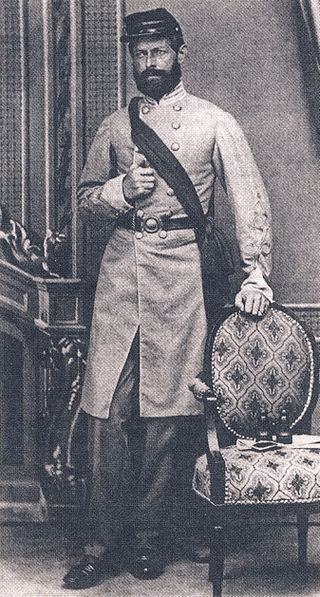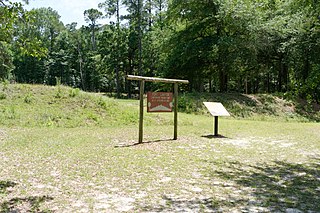
Belle Isle is a small 54-acre (22 ha) island in the city of Richmond, Virginia. Belle Island lies within the James River, and being owned by the city it serves as a city park. It is accessible to pedestrian and bicycle traffic via a suspension footbridge that runs under the Robert E. Lee Memorial Bridge from the northern shore or via a wooden bridge from the southern shore. Except when the water level of the James is high, it is also reachable by foot from the southern shore via easy boulder-hopping. From Belle Isle, one can see Hollywood Cemetery, the old Tredegar Iron Works, and Richmond City's skyline. Belle Isle has many bike trails around the island, and has a small cliff used for rock climbing instruction.

The postage stamps and postal system of the Confederate States of America carried the mail of the Confederacy for a brief period in American history. Early in 1861 when South Carolina no longer considered itself part of the Union and demanded that the U.S. Army abandon Fort Sumter, plans for a Confederate postal system were already underway. Indeed, the Confederate Post Office was established on February 21, 1861; and it was not until April 12 that the American Civil War officially began, when the Confederate Army fired upon US soldiers who had refused to abandon the fort. However, the United States Post Office Department continued to handle the mail of the seceded states as usual during the first weeks of the war. It was not until June 1 that the Confederate Post Office took over collection and delivery, now faced with the task of providing postage stamps and mail services for its citizens.

Henry Wirz was a Swiss-born American military officer and convicted war criminal who served in the Confederate States Army during the American Civil War.

The Andersonville National Historic Site, located near Andersonville, Georgia, preserves the former Andersonville Prison, a Confederate prisoner-of-war camp during the final fourteen months of the American Civil War. Most of the site lies in southwestern Macon County, adjacent to the east side of the town of Andersonville. The site also contains the Andersonville National Cemetery and the National Prisoner of War Museum. The prison was created in February 1864 and served until April 1865.

Johnson's Island is a 300-acre (120 ha) island in Sandusky Bay, located on the coast of Lake Erie, 3 miles (4.8 km) from the city of Sandusky, Ohio. It was the site of a prisoner-of-war camp for Confederate officers captured during the American Civil War. Initially, Johnson's Island was the only Union prison camp exclusively for Confederate officers but eventually it held privates, political prisoners, persons sentenced to court martial and spies. Civilians who were arrested as guerrillas, or bushwhackers, were also imprisoned on the island. During its three years of operation, more than 15,000 men were incarcerated there.

Andersonville is a 1996 American television film directed by John Frankenheimer about a group of Union soldiers during the American Civil War who are captured by the Confederates and sent to an infamous Confederate prison camp.

The 52nd Pennsylvania Infantry was a volunteer infantry regiment in the Union Army during the American Civil War.

Andersonville is a novel by MacKinlay Kantor concerning the Confederate prisoner of war camp Andersonville prison during the American Civil War (1861–1865). The novel was originally published in 1955, and won the Pulitzer Prize for Fiction the following year.

Salisbury National Cemetery is a United States National Cemetery located in the city of Salisbury, in Rowan County, North Carolina. It was established at the site of burials of Union soldiers who died during the American Civil War while held at a Confederate prisoner of war camp at the site.
Florena Budwin was a Union Army soldier from Philadelphia who, disguised as a man, enlisted with her husband, an artillery captain, in the Civil War in order to stay with him. After being captured, she died of complications of pneumonia. She was buried in Florence National Cemetery, the first woman soldier to be afforded that honor.

Camp Ford was a POW camp near Tyler, Texas, during the American Civil War. It was the largest Confederate-run prison west of the Mississippi.

Elmira Prison was originally a barracks for "Camp Rathbun" or "Camp Chemung", a key muster and training point for the Union Army during the American Civil War, between 1861 and 1864. The 30-acre (120,000 m2) site was selected partially due to its proximity to the Erie Railroad and the Northern Central Railway, which crisscrossed in the midst of the city. The Camp fell into disuse as the war progressed, but its "Barracks #3" was converted into a military prison in the summer of 1864. It was the prison holding the largest number of Confederate POWs. Its capacity was 4,000, but it held 12,000 within one month of opening. A different source says that Camp Rathbun had a capacity of 6,000 recruits, but that it was turned into a prison for 10,000 and the Union Commissary General was given just 10 days to make it happen.
Galvanized Yankees was a term from the American Civil War denoting former Confederate prisoners of war who swore allegiance to the United States and joined the Union Army. Approximately 5,600 former Confederate soldiers enlisted in the United States Volunteers, organized into six regiments of infantry between January 1864 and November 1866. Of those, more than 250 had begun their service as Union soldiers, were captured in battle, then enlisted in prison to join a regiment of the Confederate States Army. They surrendered to Union forces in December 1864 and were held by the United States as deserters, but were saved from prosecution by being enlisted in the 5th and 6th U.S. Volunteers. An additional 800 former Confederates served in volunteer regiments raised by the states, forming ten companies. Four of those companies saw combat in the Western Theater against the Confederate Army, two served on the western frontier, and one became an independent company of U.S. Volunteers, serving in Minnesota.

The Immortal Six Hundred were 600 Confederate officers who were held prisoner by the Union Army in 1864–65. In the summer of 1863, the Confederacy passed a resolution stating all captured African-American soldiers and the officers of colored troops would not be returned. The resolution also allowed for any captured officer of colored troops to be executed and any captured African-American soldier be sold into slavery. The resolution caused a breakdown in the exchange of captured soldiers as the Union demanded all soldiers be treated equally. The Immortal Six Hundred were one group of officers who could not be exchanged.

John Henry Winder was a career United States Army officer who served with distinction during the Mexican–American War. He later served as a Confederate general officer during the American Civil War.
The Andersonville Raiders were a band of rogue soldiers incarcerated at the Confederate Andersonville Prison during the American Civil War. Led by their chieftains – Charles Curtis, John Sarsfield, Patrick Delaney, Teri Sullivan, William Collins, and Alvin T. Munn – these soldiers terrorized their fellow prisoners, stealing their possessions and sometimes even committing murder.

Father Peter Whelan was an Irish-born Catholic priest who distinguished himself as a chaplain for both Confederate troops and Union prisoners of war during the American Civil War. Father Whelan previously served as a missionary in North Carolina and pastor of Georgia's first Catholic parish, and twice served as administrator of the entire Diocese of Savannah.

Between 1861 and 1865, American Civil War prison camps were operated by the Union and the Confederacy to detain over 400,000 captured soldiers. From the start of the Civil War through to 1863 a parole exchange system saw most prisoners of war swapped relatively quickly. However, from 1863 this broke down following the Confederacy's refusal to treat black and white Union prisoners equally, leading to soaring numbers held on both sides.

The Alton Military Prison was a prison located in Alton, Illinois, built in 1833 as the first state penitentiary in Illinois and closed in 1857. During the American Civil War, the prison was reopened in 1862 to accommodate the growing population of Confederate prisoners of war and ceased to be prison at the end of the war in 1865. The prison building was demolished not long after the Civil War. All that remains of the former prison site is a section of ruin wall that is maintained by the State of Illinois as an historic site. The prison site is included in the U.S. National Register of Historic Places.

Camp Lawton or the Millen Prison was a stockade which held Union soldiers who been taken as prisoners-of-war during the American Civil War. Located beside the Augusta and Savannah Railroad right-of-way five miles north of what was then Millen Junction in Burke County, the new prison facility was modeled after Camp Sumter. It opened in October 1864 but had to be evacuated within six weeks, due to the advance of Sherman's army through Georgia. With an area of 42 acres (17 ha) and holding over 10,000 of a planned 40,000 men, it was said to be the largest prison in the world at that time.























